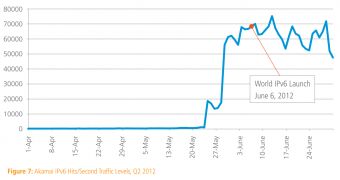As the world's IPv4 address reserves dry out, there doesn't seem to be a big hurry to switch to IPv6 addresses which are as plentiful as the grain of sands on the beaches and the stars in the skies.
Literally, the theoretical limit is 2128 or 340 trillion trillion trillion addresses. Suffice it to say that there are enough addresses for the foreseeable future for us and any ET that may be lurking around Alpha Centauri.
Still, 2012 was one of the biggest years for IPv6 and saw the biggest bump in adoption and support.
That had a lot to do with IPv6 Launch day, this June, which saw several big internet companies, websites, CDNs as well as ISPs, start supporting IPv6 by default.
Surprisingly enough, the uptake in usage wasn't on the set IPv6 Launch day, it actually happened in advance.
That's because companies didn't want a big surge of traffic in one day, so they enabled support ahead of the set date to smooth out any problems.
Akamai, which has just issued its quarterly broadband report, did just that, enabling its customers to start supporting IPv6 connections several months before the launch day.
The results are self-evident, Akamai saw no big spike on or after IPv6 Launch Day, but saw a surge in traffic ahead of that as its clients enabled support.
"IPv6 traffic levels on Akamai grew significantly as several major customers IPv6-enabled their Web sites and embedded content. However, because so many customers enabled IPv6 support ahead of World IPv6 Launch, there was no 'big spike' that occurred in the days immediately preceding, or during the day of, the event," Akamai explained.
"Traffic continued to grow into the World IPv6 Launch event, reaching a quarterly peak several days thereafter, and traffic patterns for the remainder of the quarter appeared to settle into something of a weekly peak & trough pattern that is similar to traffic graphs from content delivered over IPv4," it added.

 14 DAY TRIAL //
14 DAY TRIAL //